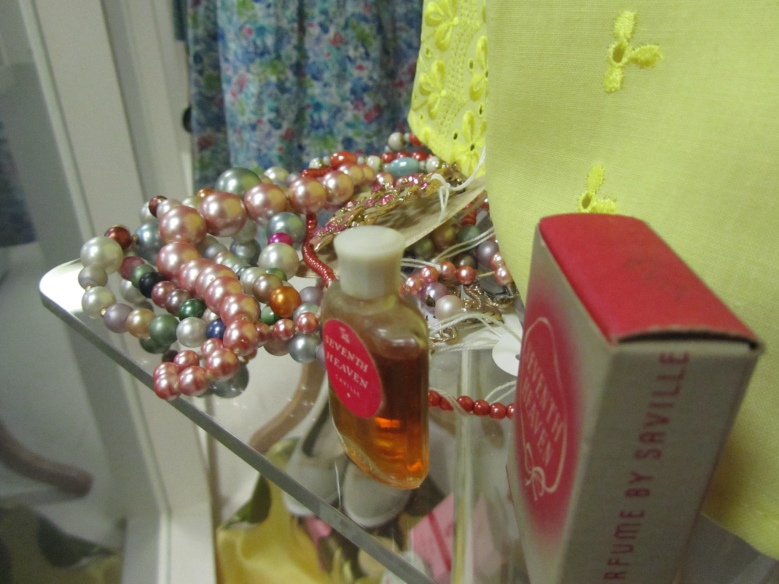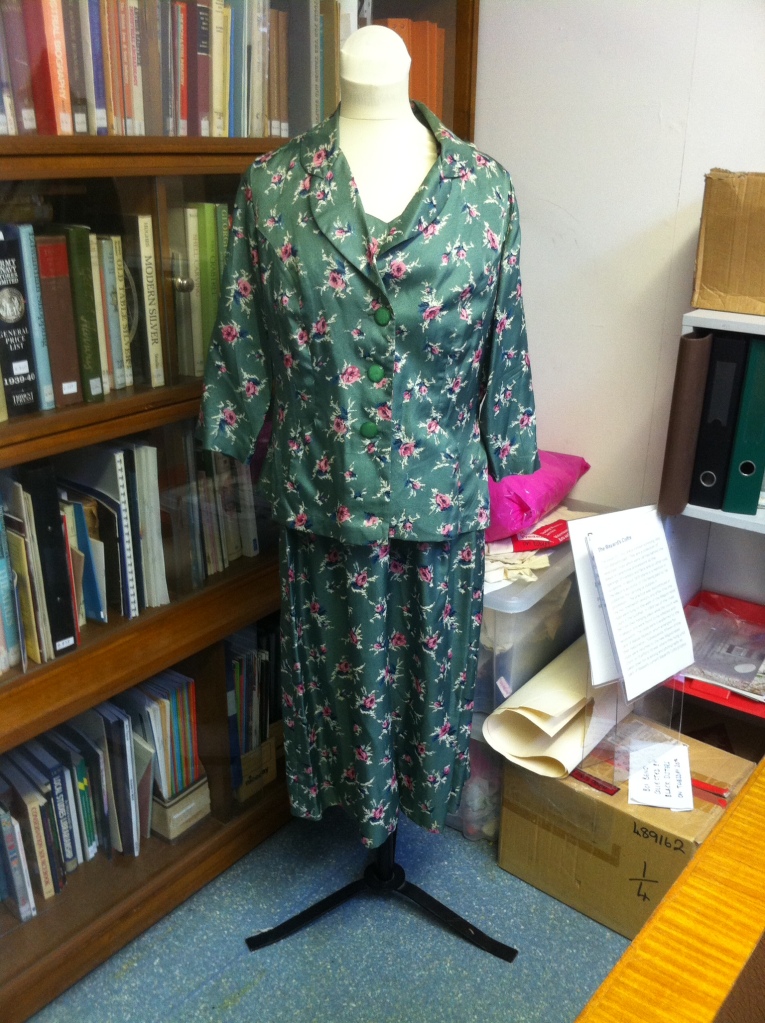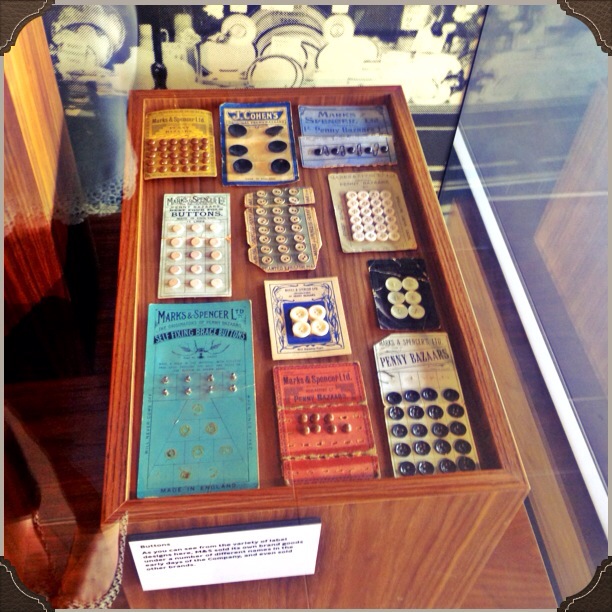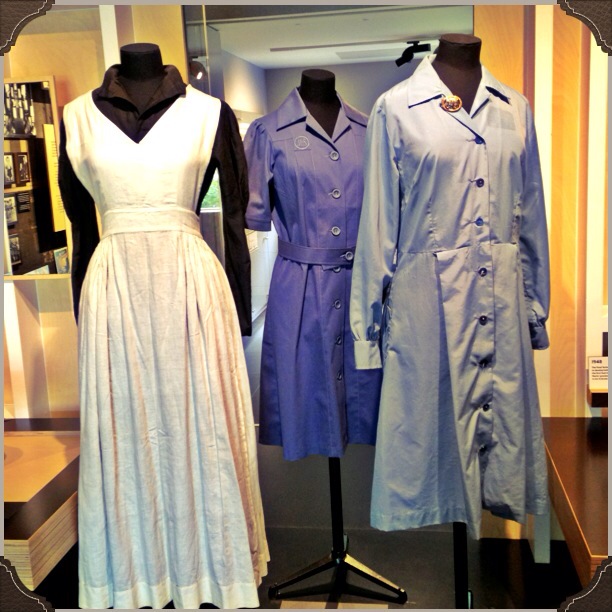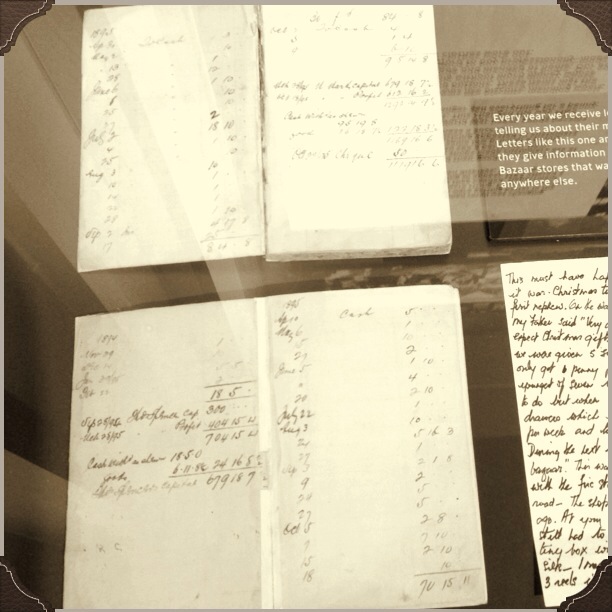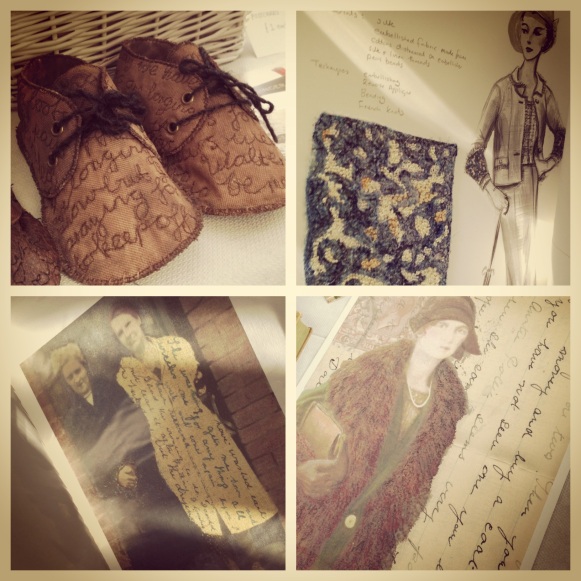Tagged: 1950s
Exhibition: Austerity to Prosperity
I was honoured and excited when Walsall Museum invited me to take part in planning this exhibition. My brief was to select items from the Hodson Shop Collection that told the story of the transition from wartime austerity to the relative prosperity of the 1950s. The clothing in the collection fits perfectly within this tumultuous period and provides evidence of what Black Country women were wearing during the post-war period. There are the simple yet subduedly elegant utility (CC41) dresses that fade away as the 1950s get into full swing, with full skirts and vivid prints taking over.
My main aim was not to oversimplify the narrative of change; the myth that everyone woke up on 1st January 1950 to find that the drab wartime world had been replaced by a new consumer-driven technicolor dream world. The 1940s may have been a time of austerity but there was still colour, beauty and a booming demand for little luxuries such as lipstick and face powder. Conversely, the 1950s remained austere for many, with food rationing only coming to an end in 1954 (clothing rationing ended in 1949). I reflected this by choosing a few unusual items: a ‘Wartime emergency pack’ of face powder, a surprisingly frilly utility dress, a distinctly dreary wool jersey dress from the 1950s next to a full-skirted confection of a dress from the same time.
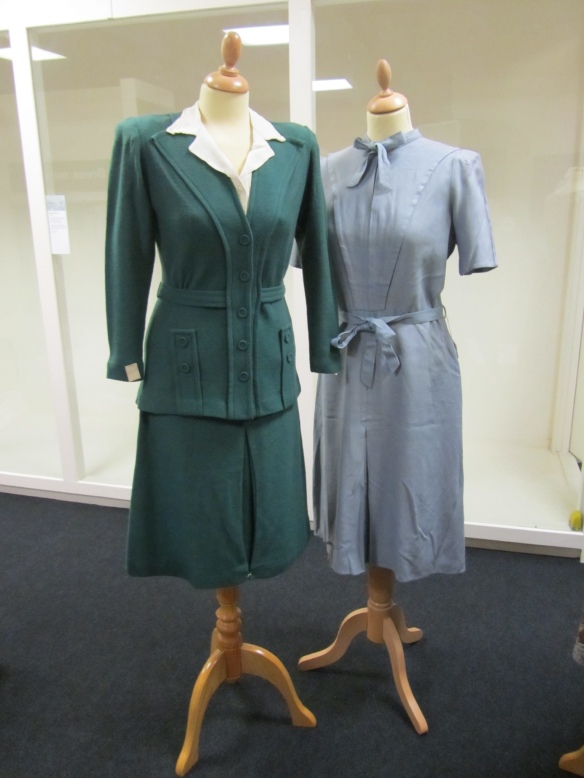
Utility items from the Hodson Shop Collection – creases have been kept in the dress as that is how it was discovered in the Hodson Shop.
Installing the exhibition was great fun and an excellent learning opportunity. I’m really proud of the end result, especially the bit that includes a 1950s twin-tub washing machine!
The clothing accompanies a display of items manufactured or used in the Black Country during the period 1940-1960, again reflecting the aesthetic and ideals of the shift from austerity to prosperity. The exhibition is part of the region-wide Black Country Echoes festival and runs 3 Sept-10 Jan 2015. Admission is free.
Thanks to the team at Walsall Museum for providing me with this opportunity and supporting me along the way!
From Austerity to Prosperity
3 Sept 2014-10 Jan 2015
Community History Gallery, Walsall Museum, Lichfield Street, Walsall.
The Mystery of Morrish & Co.
It all began when I was examining a dress and jacket suit recently accessioned to Walsall Museum’s Community Costume Collection. It was a green crepe ‘sunday best’ style outfit, with a cheery pink rose print. It is from late 1950s or early 1960s (though I could do with doing a bit more research to confirm this). In my more fanciful moments, I can picture Edith or Flora Hodson wearing it whilst bustling off to church or to some family occasion.
Sheila Shreeve found the outfit in a wardrobe at 54 New Road (the property was both the family home and business premises) and there had been some discussion regarding the relationship between the ensemble and the Hodson Shop Collection. The outfit has some very clear signs of wear – soiling around the neckline, evidence of altered hems and repairs and there is even a brooch pinned to the right hand bust. The Hodson Shop Collection is defined as unworn shop stock, with ‘unworn’ being the operative word in this case. Based on the evidence of wear, the outfit was ultimately accessioned into the Community Costume Collection with a note making the relationship to the Hodson Shop clear.
My own study of the garment involved examining the garment inside and out. It was during this process that I noticed the marking under the arms, the repairs in subtly different thread and the clear line of an adjusted hem. I also came across a paper label stitched into the left hand seam of the dress. I can’t find the photo of the label so I will try my best to take one on my next visit to the museum (you can see similar here). From my research notes:
A rectangular paper label is stitched into the left side seam. It is reinforced with a textile mesh on the reverse side. Measures 30mm W x 40mm H. Text is printed in black serif: “MORRISH, LONDON, W1 Ref. C. Style (stamped, red) 194 Prod. (stamped, red) 20035 Mach. (handwritten, pencil) 15 Fin. (stamped, red) 46 Presser Size (stamped, red) 44”
This is where I went wrong. Based on my own experience of clothing labels, I assumed that Morrish were the manufacturers of the outfit. After all, the labels in modern clothing always give the name of the manufacturer, right? This is where the Prownian approach (description, deduction, speculation) to analysing garments proved to be most valuable. It was time to test my hypothesis!
And it turns out that it was very, very wrong. I spent a fascinating afternoon trying to find out who Morrish were. It began, as do many modern adventures in dress history, with a hunt on eBay. I came across several vintage items listed as “Morrish & Co.”, including one rather pretty organza party frock that I came dangerously close to buying (in the name of research, of course). Things got interesting on Etsy where I noticed that listings were far more cautious, referring to ‘order labels’ bearing the name Morrish & Co., as opposed to the stating the company as the manufacturers of the garments. Lots of the garments I came across were listed as appearing to be handmade and there was no real continuity in their style (a sweet party frock one minute, a leopard print-lined leather coat the next). The next phase of my online odyssey took me to an entry on a Vintage Fashion Guild forum. A user called ‘Leonardo da Vintage’ was enquiring about a 50s wiggle dress baring a very similar label. She asked the following questions:
It has a paper hand written label sewn into a seam – what does that indicate? I’ve looked up Morrish & Co, London W1, and the only possibly relevant company made stationary, bags and then shop fittings – so perhaps they made the label, rather than the dress?
Maybe Morrish & Co. weren’t clothing manufacturers after all? Armed with the company name and postcode I decided to search through some trade directories. I hit gold in the Post Office London Directory, 1915 (you can access them via University of Leicester’s wonderful Special Collections Online ‘Historical Directories of England and Wales’) . Listed under ‘PRI’ (which is possibly short for ‘Printers’?) on page 471 I found the following entry :

The listing for Morrish & Co in the 1915 Post Office London Directory. Image via University of Leicester Special Collections Online
I then Googled ‘Morrish & Co 56 Great Titchfield Street’ and the first result was for a company called Morplan. Morplan are suppliers to the fashion industry – they provide labels, ticketing, bags and hangers amongst numerous other bits and pieces essential to clothing retail and manufacture. The ‘About’ page of the website informed me that the ‘Mor’ part of the name was taken from Mr Morrish of Camberwell, SE London who founded the company in 1845. They operated using the names ‘Morrish and Chalfont’, ‘ Morrish & Co.’, ‘Morrish’ and finally ‘Morplan’. They have been operating from Great Titchfield Street, W1 since approx. 1894.
So there’s one mystery pretty much solved: Morrish & Co. made the labels NOT the dresses. I’m not sure how much of this is common knowledge within dress history and vintage circles but it is clearly a red herring that catches many vintage sellers and students like me out. As one mysterious case closes, another one has opened: who made the green ‘Sunday Best’ outfit? I can see this turning into a mammoth trawl through the Hodson Shop Archive. I’ll let you know when I find anything out!
I’m also now beyond intrigued in the history of Morrish & Co. and their links with the fashion industry. Please let me know if you are aware of any research on them. I’ve never really stopped to think about who makes the labels in my clothing, they are one of those small and largely ignored parts of everyday life and dress. There’s a nice project in that somewhere!
Picture Post: Exploring the Hodson Shop Archives
After a busy few weeks (more on which in a future post), it has been a pleasure to finally get back to hands-on archival research. I’ve spent a few days digging through the Hodson Shop archive of trade catalogues, seeking out links to any of the items I have encountered during my object analysis. Plenty have emerged as I’ve worked my way through piles of trade brochures for Birmingham wholesalers such as Wilkinson and Riddell, S.C Larkin and Sons and Bell and Nicholson. The images below are of some of the things that have caught my eye. They aren’t always hugely relevant to my research but they are the things that have raised some intrigue, a smile or a giggle.
I’ve attempted to give as much detail as possible for each image, though I forgot to note the date and wholesaler for this Christmas apron image. I think it is late-1940s/early-1950s Bell and Nicholson, though I’ll double check when I am next at the museum and update the caption accordingly.
I’ve posted before about underwear and how the collection highlights changing attitudes and approaches to undergarments from 1920s-1960s. The 1920s Queen of Scots promotional material is a prime example of this: hygiene and comfort, alongside endorsement from a pious historical figure (c.f. Cardinal Wolsey and his stockings). This is something that I really want to do some more research into (proposed paper title: Piety, Purity and Pants). If you know of any existing work on early-20th century underwear marketing, please let me know!
The 1930s Wilkinson and Riddell catalogue covers are especially stunning – with their Japanese influences and bold artwork. There is something rather charming about their Greyhound logo, especially when placed next to a bonsai tree. The pink and yellow gladioli cover is a personal favourite.
The S.C. Larkin and Sons brochure, New Designs for 1930. Maids’ and Nurses’ Caps, revealed links to Walsall’s famous Sister Dora – the nurse and nun who revolutionised approaches to nursing during the mid-ninteenth century. She created a simple cap for nurses to wear and the brochure shows the design in a number of styles ‘suitable for bobbed hair’.
The final image is of some scribbled notes that I found inside a 1954 Bell and Nicholson catalogue, possibly by Edith or Flora Hodson. There was something eerie about coming across these notes and doodles – as if they were a direct link back to the women and what was going on inside their heads. I’ve seen their handwriting many times before but it has mainly been scrawled numbers or scrappy receipts. These notes seem more personal. And that little sketch of a head? Well, I’m filing that under ‘a bit creepy’.
Many thanks to Walsall Museum for providing me with access to the archive and for allowing me to photograph the items.
If you wish to explore the Hodson Shop Collection and Archive, please contact Walsall Museum.
Tel: 01922 653116
Email: museum@walsall.gov.uk.
Current Exhibition: Red! @ Walsall Museum

From left: printed cotton day dress, c.1951 (Hodson Shop Collection), red grosgrain short evening dress with roses, c.1958.
Sometimes it is the simplest ideas that prove to be the most effective, as evidenced by Walsall Museums latest dress exhibition: Red!
As you might have figured from the title, the exhibition is a celebration the colour red, most specifically the iconic red dress.
All of the dresses have been drawn from Walsall Museum’s massive costume collection and include several items from the Hodson Shop Collection. The dresses are organised in chronological order, starting with this stunning striped muslin day dress from the 1850s (pictured below) and working their way up to this slinky satin wrap dress from the early 1990s (I love the fact that this dress is from Etam). And somewhere in the middle is this grosgrain Wishick and Webber stunner from 1958 (pictured top right).
Hodson Shop dresses include a 1920s cotton day dress with a pointed collar and daisy print, aCC41 (utility) rayon crepe dress with a belt and button details and a 1950s floral print day dress, scattered with stripes and roses (pictured top left). Even though the Hodson dressed are far from the glitziest items on display, they certainly manage to hold their own amongst the frills and flounces.
The visual impact of the colour is undeniable, whether the dress is a glitzy beaded flapper number or a simple utility dress. It is a great starting point for planning outfits for the upcoming party season!
Red! runs until 18th January 2014 at Walsall Museum, Changing Face of Walsall Gallery on the first floor of the Walsall Central Library building. Admission is free! See What’s On Walsall for more details.
The M&S Archive and CHORD 2013
What does the Hodson Shop have in common with Marks and Spencer? “Not a vast amount beyond selling clothes” would have been my initial answer but that has changed somewhat since spending a day at the M&S Archive.
I was there for the CHORD 2013 conference on historical perspectives around retailing and the senses. The papers were fascinating, as ever. I particularly enjoyed Anneleen Arnout’s paper on the sensory aspects of the Galeries Saint-Hubert in 19th century Brussels and Ai Hisano’s history of cellophane in US food packaging. Ben Highmore’s take on Habitat’s “sensual orchestration” really got me thinking about shops as both retail and educational spaces – where people learn about design through their senses. There are clear parallels with museums within this, though this post isn’t the place for me to ramble on about those!
Instead, I want to tell you all about the M&S Archive and explain how it links with the Hodson Shop Project.
The archive contains approximately 70,000 items and is located within the Michael Marks building, University of Leeds. There’s an exhibition space on the ground floor, which is well worth a visit. The display cases contain items that tell the story of M&S over the decades – from the Penny Bazaars of the 1890s to the present day of Per Una and Percy Pigs. Researchers can also arrange access to the collections and there are excellent facilities for study.
There were some fabulous items on display. I couldn’t get over the floral print on this pair of early “Shapewear” pants (above)! The knitted swimwear from the 1920s also raised a few smiles. Yet it wasn’t all about clothing. In fact, garments only account for 1,700 items within the archive, with the rest being mainly documents relating to management, finance and product design and innovation.
Our guide, Katherine Carter explained to us that it is often a mad scramble to ensure that evidence and artefacts are collected and archived due to the fast pace of 21st century retail. Their collecting policy for clothing is to keep samples of ‘high volume sellers’ (this could be something as simple as a plain white t-shirt), garments seen on celebrities and public figures (e.g. Samantha Cameron’s polka dot dress) and garments incorporating significant innovations in textile technology.
We got to look at the ‘strong room’ where the collection is stored. I was impressed by the high-tech racking system they have in place and the pristine orderliness of the clothing collection. The garments may not have huge monetary worth and be distinctly ‘everyday’ but M&S clearly value their history.
During our tour of the exhibition space, Katherine explained how the company had evolved from a market stall in Leeds to the globally recognisable super-brand of today. It is strange to think that one of the earliest big sellers was sheet music that sold for one penny. The inflation of the 1920s made the ground breaking ‘everything’s a penny’ sales strategy impossible to maintain, leading the company to diversify and experiment with new products and branding. They introduced their first bra in 1926 and started to sell a range of simple, loose fitting garments (the loose fit was necessary due to the infancy of mass production techniques).
I was intrigued to hear that M&S technologists had worked with the government during WWII to develop what would become the CC41 (utility) scheme. It was striking to see a simple, yet elegant, utility dress next to the full and flouncy fifties floral frock. Katherine used the phrase ‘wonder fabrics’ when talking about the scientific breakthroughs of the fifties that kick started the period love affair with man-made fibres.
The 1960-1970s case was a delight. It was amusing to see how the company had attempted to keep up with the youthful freedom of the period – their first campaign with Twiggy was launched in 1968, whilst their Young St Michael range was endearingly innocent and ever-so slightly wide of the mark!
Ready meals and convenience foods were highlighted as the next major breakthrough. The not very appetisingly named ‘Boil in the Bag Ravioli’ was launched in 1971, with Indian ready meals and lasagnes following in 1972. Apparently, they were edible status symbols – with high price tags.
Fast-forwarding to 2009 and M&S celebrated the 150th anniversary of Michael Marks’ birth. The display featured limited edition archive-based garments. This anniversary marked the point when the design team began to search through the archives for creative inspiration.
There were also displays of staff uniforms from across the decades – from the early floor length black dresses worn with crisp white aprons, to the man-made fibre extravaganzas of the 1950s. A visitor assistant called Janet kindly talked me through these displays. She had worked for M&S since she was a teenager and even showed me a picture of her young self in a smart M&S uniform! She told me how her employers trained her in everything from grooming to dental hygiene. There is a clear sense of ‘family’ amongst M&S employees.
Janet also pointed me to a cabinet containing diaries belonging to Michael Marks and Tom Spencer for 1894 (the first year of the partnership). They detail Tom Spencer’s initial £300 investment in the company – humble items that capture a turning point in retail history.
So what exactly do the Hodson Shop Collection and M&S archive have in common? My first thought was that they are both collections of stock and documentation of a single business. They also cover a similar time period. In both cases, items are not spectacular, expensive or glamorous. The garments in the M&S collection are not displayed in relation to a specific wearer – making them, in a sense, ‘unworn’ (I would love to establish how many of the garments in their collection have been worn and how many have not). On a more practical level, I noticed that some of the brands featured in earlier displays were the same as found in the Hodson Shop Collection, such as Dewhurst’s and St Margaret (the latter being the inspiration behind the St Michael brand name which was dropped in 2000).
Whilst there are some parallels, I am aware that the items in the M&S archive are there due to their association with a much-loved and renowned brand and business. Michael Marks and Tom Spencer have a lofty position in retail history whilst Edith and Flora Hodson are minor players. People visit the M&S exhibition because it resonates with them on a personal level and this resonance is widespread, across the country and generations.
Massive thanks to: the team at the M&S archive (especially Katherine and Janet), Laura Ugolini and Karin Dannehl from University of Wolverhampton who organised the CHORD conference and all of the speakers at the event.
Current Exhibition: Summer on the Beach @Walsall Museum
Fun fact: The Hodson Shop Collection contains no beachwear. I need to do a bit of digging as to why this might be but I have a couple of theories:
1) Willenhall is about as land-locked as a town can be, so a swimming costume would be more of a luxury than a necessity.
2) The Hodson Shop simply wasn’t the sort of place that sold swim wear – maybe bathing suits were purchased from more specialist retailers?
Whilst Edith and Flora Hodson might not have been purveyors of bikinis and bathing costumes, the people of Walsall borough definitely had a desire to splash around at the seaside!
Walsall Museum’s Summer on the Beach exhibition gives a vibrant overview of 20th century beachwear, drawing from the Museum’s extensive Community History Costume Collection.
Can you picture yourself parading along the beach in a psychedelic seventies bikini or sunning yourself in a floral fifties bathing suit with puffed skirt? How about dodging waves in a heavy stockinette Edwardian bathing dress? And for the men they have just the thing for taking a dip, a thick woollen swimming suit.
Summer on the Beach is on show from Thursday 13 June until Wednesday 11 September 2013. It can be seen within Walsall Museum’s Changing Face of Walsall gallery on the first floor of the Central Library building. Entry to the Museum is free of charge, for further information please contact 01922 653116 or email museum@walsall.gov.uk.
Note: The pictures below aren’t from the actual exhibition – they were taken at an event earlier in the year. Both of these swimming costumes feature in the exhibition and give a good idea of the flamboyant and colourful nature of the swimwear. I’m pretty smitten with the butterfly print number!
Appreciating the Pretty Things
It has been a while since my last post. I’ve been busy over the past few weeks – finishing the object analysis stage of my research, preparing for interviews with museum staff and delivering two presentations about the Hodson Shop Project.
During this time, I’ve been lucky to attend two CHORD workshops and a study day at the University of Chester about the Textile Stories project, organised by Professor Deborah Wynne. It is always a pleasure to go along to such events and meet people who are passionate about clothing and history. It is especially exciting to have a chance to talk about my research with these people!
I’m still very much in the thick of it research-wise, so this post is more a collection of some of the gorgeous images that I have captured in the course of my studies over the last month or so.
It is quite refreshing to step back from detailed analysis and to simply appreciate something because it is pretty. Some objects and garments make people smile, a factor which is arguably undervalued in studies of material culture. And sometimes that smile is enough. There are no long-winded descriptions or complex biographies for any of the items picture below. Enjoy.


